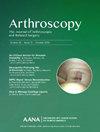Discoid Lateral Meniscus Evaluation and Treatment
IF 4.4
1区 医学
Q1 ORTHOPEDICS
Arthroscopy-The Journal of Arthroscopic and Related Surgery
Pub Date : 2025-05-29
DOI:10.1016/j.arthro.2025.03.003
引用次数: 0
Abstract
Discoid lateral meniscus (DLM) is a variant of meniscal histomorphology that often presents in young, active pediatric populations. Patients may present with mechanical symptoms, joint line pain, swelling, and loss of motion especially with lack of terminal knee extension. DLM are prone to tearing, most frequently with horizontal patterns in children and complex patterns in adults. The PRiSM classification and assessment of DLM provide a comprehensive approach to evaluating DLMs arthroscopically, focusing on the following four factors: (1) meniscal width, (2) meniscal height, (3) stability, and (4) the presence of tearing. Meniscal width is defined as complete (Watanabe class I) or incomplete (Watanabe class II). Meniscal height is defined as normal or abnormal. DLMs may be stable, unstable posteriorly (Watanabe class III), unstable anteriorly, or unstable both anteriorly and posteriorly. After appropriate saucerization, the meniscus is carefully evaluated for the presence of a tear, and, if present, the tear type and location are noted. Multiple surgical tips may facilitate appropriate treatment of symptomatic DLMs. A more proximal and medial anteromedial portal should be created directed over the tibial spines into the lateral compartment for optimal working trajectory. Small joint and 70° scopes may also facilitate viewing in select cases. Switching portals frequently allows for a more complete assessment and treatment of DLMs. During the process of saucerization, the popliteal hiatus should be visualized, and this area is often thickened and enlarged which can contribute to meniscal instability. A variety of biters, shavers, and blades may be necessary for optimal saucerization. For unstable tears, traction sutures may facilitate controlling the DLM during saucerization. Once saucerization is complete, the presence of a tear should be thoroughly assessed. If possible, tears should be repaired, and surgeons should be prepared with a variety of repair techniques in addition to marrow stimulation or biologic augmentation to improve healing potential.
盘状外侧半月板的评估与治疗
盘状外侧半月板(DLM)是一种半月板组织形态的变体,经常出现在年轻、活跃的儿科人群中。患者可能表现为机械症状,关节线疼痛、肿胀和活动丧失,特别是缺乏膝关节末端伸展。DLM易撕裂,儿童多为水平型,成人多为复杂型。DLM的PRiSM分类和评估为关节镜下评估DLM提供了一种全面的方法,重点关注以下四个因素:(1)半月板宽度,(2)半月板高度,(3)稳定性,(4)是否存在撕裂。半月板宽度定义为完全(Watanabe类I)或不完全(Watanabe类II)。半月板高度定义为正常或异常。dlm可能是稳定的,不稳定的后侧(Watanabe III类),不稳定的前侧,或前后均不稳定。在适当的碟子化后,仔细评估半月板是否存在撕裂,如果存在,撕裂的类型和位置被记录下来。多个手术提示可能有助于适当治疗有症状的DLMs。为了获得最佳的工作轨迹,应该在胫骨棘上建立一个更近和更内侧的前内侧门静脉。在某些情况下,小关节和70°范围也可以方便地观察。频繁切换门户允许对dlm进行更完整的评估和处理。在碟子化过程中,腘窝裂孔应可见,该区域常增厚和扩大,这可能导致半月板不稳定。各种各样的咬器、剃须刀和刀片可能是最佳碟子化所必需的。对于不稳定撕裂,牵引缝合线可能有助于在碟形手术期间控制DLM。一旦焖煮完成,应该彻底评估是否有撕裂。如有可能,应对撕裂进行修复,除骨髓刺激或生物增强外,外科医生应准备多种修复技术,以提高愈合潜力。
本文章由计算机程序翻译,如有差异,请以英文原文为准。
求助全文
约1分钟内获得全文
求助全文
来源期刊
CiteScore
9.30
自引率
17.00%
发文量
555
审稿时长
58 days
期刊介绍:
Nowhere is minimally invasive surgery explained better than in Arthroscopy, the leading peer-reviewed journal in the field. Every issue enables you to put into perspective the usefulness of the various emerging arthroscopic techniques. The advantages and disadvantages of these methods -- along with their applications in various situations -- are discussed in relation to their efficiency, efficacy and cost benefit. As a special incentive, paid subscribers also receive access to the journal expanded website.

 求助内容:
求助内容: 应助结果提醒方式:
应助结果提醒方式:


